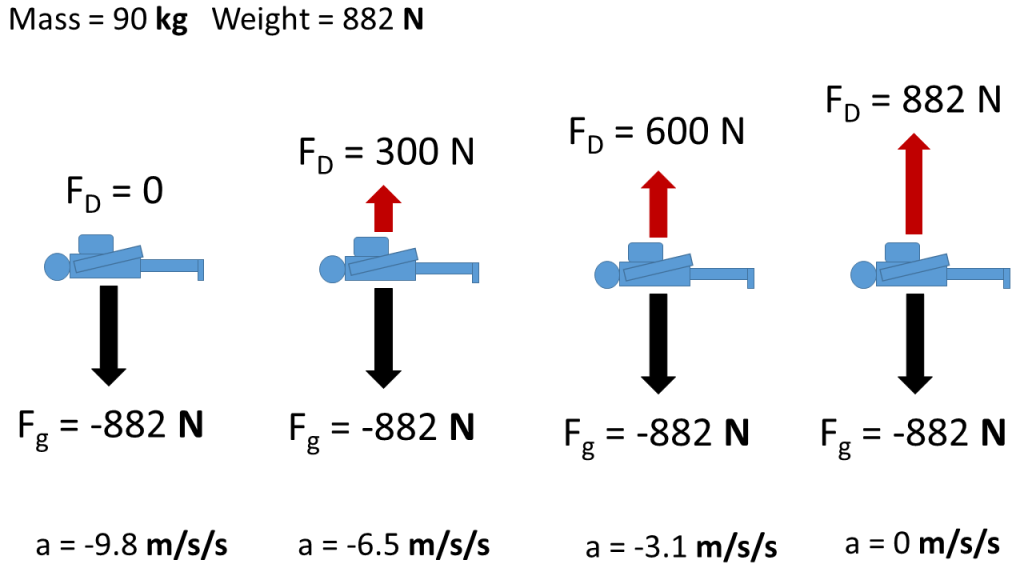Why Does a Skydiver Not Accelerate Continuously
61 Physical Model for Terminal Velocity
After jumping, a skydiver begins gaining which increases the they experience. Eventually they will move fast enough that the air resistance is equal in size to their , but in opposite direction so they have no . This processes is illustrated by for a skydiver with 90 kg mass in the following image:

With a net force of zero the skydiver must be in , but they are not in because they are not static (motionless). Instead they are in , which means that they are moving, but the motion isn't changing because all the forces are still balanced (net force is zero). This concept is summarized by , which tells us that an object's motion will not change unless it experiences a net force. Newton's first law is sometimes called the Law of Inertia because is the name given to an object's tendency to resist changes in motion. applies to objects that are not moving and to objects that are already moving. Regarding the skydiver, we are applying Newton's First Law to (back and forth, up and down), but it also holds for the effect of on changes in rotational motion. Changes in motion are known as accelerations and we will learn more about how net forces cause translational accelerations in upcoming chapters.
Everyday Example: Head Injuries
 Diagram of a concussion. "Concussion Anatomy" by Max Andrews via wikimedia commons.
Diagram of a concussion. "Concussion Anatomy" by Max Andrews via wikimedia commons.
[1]
When the head is travelling in a certain direction with constant speed the brain and skull are moving together. If an impact causes the the motion of the skull to change suddenly, the brain tends to continue its original motion according to of Motion. The resulting impact between the fragile brain and the hard skull may result in a concussion. Recent research has shown that even without the occurrence of concussions, the damage caused by sub-concussive events like this can accumulate to cause Chronic Traumatic Encephalopathy (CTE)[2].
Reinforcement Exercises
We already know from our experimental work during the Unit 3 lab that increasing leads to increasing . We can now understand that this behavior occurs because greater mass leads to a greater and thus a greater speed required before the () is large enough to balance out the weight and is achieved.
Everyday Example: Tandem Skydive
First-time skydivers are typically attached to an instructor (tandem skydiving). During a tandem skydive the bodies are stacked, so the shape and of the object don't change much, but the does. As a consequence, the for tandem diving would be high enough to noticeably reduce the fall time and possibly be dangerous. Increasing the to account for the extra mass is accomplished by deploying a small chute that trails behind the skydivers, as seen in the photo below.

[3]
When the skydiver has reached and remains in a state of , we know the size of the must be equal to the skydiver's , but in the opposite direction. This concept will allow us to determine how the skydiver's should affect terminal speed. We start be equating the air resistance with the weight:
![]()
Then we insert the formulas for and for of an object near Earth's surface. We designate the in the resulting equation ![]() because these two forces are only equal at terminal speed.
because these two forces are only equal at terminal speed.
![]()
We then need to solve the above equation for the .
(1) ![]()
Everyday Examples: Terminal Speed of the Human Body
Let's estimate the of the human body. We start with the previous equation:
![]()
We need to know the , , of air, and of the human body. Let's use the authors 80kg mass and the density of air near the Earth's surface at standard pressure and temperature, ![]() . Drag coefficient and cross sectional area depend on body orientation, so let's assume a standard skydiving posture: flat, horizontal, with arms and legs spread. In this case the drag coefficient will likely be 0.4-1.3. A reasonable value would be
. Drag coefficient and cross sectional area depend on body orientation, so let's assume a standard skydiving posture: flat, horizontal, with arms and legs spread. In this case the drag coefficient will likely be 0.4-1.3. A reasonable value would be ![]() [4]. To approximate the cross-sectional area we can use the authors average width of 0.3m and height of 1.5 m for an area of
[4]. To approximate the cross-sectional area we can use the authors average width of 0.3m and height of 1.5 m for an area of ![]()
Inserting these values into our terminal speed equation we have:
![]()
Reinforcement Exercises
We have now analyzed the skydive after was reached. Prior to this point the forces of drag and weight are not equal, therefore the skydiver is not in and speed will change over time. In order to analyze the early part of the skydive we need to quantify changes motion and learn how those changes are related to the net force. The next chapters will help us with those two goals.
Source: https://openoregon.pressbooks.pub/bodyphysics/chapter/equilibrium-2/
Post a Comment for "Why Does a Skydiver Not Accelerate Continuously"